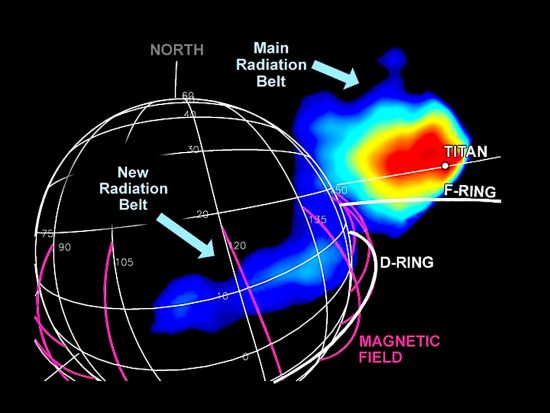
Sep 18, 2019
In an Electric Universe, celestial bodies are not isolated islands in space.
Most of the time planets and moons are not in a stable electrical condition because they are moving across plasma filaments within the Solar System, or if a moon, in the plasmaspheres around planets.
The plasmasphere of Saturn electrifies its environment, causing dark-mode plasma discharges to impinge on its family of moons. Enceladus, Dione and Tethys are all electrically active, flinging vast quantities of charged particles into space. Each moon is connected to its parent and to one another through the aforementioned circuits.
Planets with magnetic fields can trap fast-moving particles to form giant electrified clouds, more accurately called electric currents. NASA scientists have noted that Saturn’s magnetic field bends around Enceladus “due to electric currents generated by the interaction of atmospheric particles and the magnetosphere of Saturn.” Further flattening of the plasma torus on the sunward side demonstrates an electrical effect is occurring between Saturn and the Sun.
NASA scientists found a direct relationship “…between mysterious, periodic signals from Saturn’s magnetic field and explosions of hot ionized gas, known as plasma, around the planet.”
Researchers discovered plasma toroids around Saturn that contain regions of increased charge density that generate strong periodic signals in measurements of the planet’s magnetic field. The cyclic nature of the signals interferes with charting Saturn’s rotational rate.
As consensus theories propose, hot plasmas surrounding Saturn “explode,” causing magnetic field lines to stretch. Centrifugal force initiated by “cold dense” plasma erupting from Enceladus stretches them to the point where they “snap back,” releasing heat. The process is also known as “magnetic reconnection.”
Planetary magnetospheres are said to deform like teardrops, because they are bombarded by a powerful stream of charged particles that crackle out from the Sun. As the fields are pushed on the sunward side of a planet, they stretch out on the other side, where they are said to “unravel” and “flap like a flag waving in the wind.”
According to theory, when those magnetic field lines cross and “reconnect” through some unknown mechanism, they detonate, releasing large quantities of heat, light, and electrical energy.
However, magnetic field lines cannot be the storehouse for so-called “magnetic energy” because the field lines are no more real than the arrows used to describe an electric field, or the curved lines that indicate highs and lows on a weather map. Besides, a magnetic field is a continuum for all practical purposes, it is not quantized into discrete bands.
To say that magnetic field lines can cross, or flap, or snap and reconnect is tantamount to saying that weather diagrams can produce rain.
Retired professor of Electrical Engineering; Dr. Donald Scott writes about the other feature thought to be “mysterious” by the data analysts: the “clump” of electrified particles synchronized with the planet’s rotation.
“I do feel they would stand a better chance [of understanding] if they would recognize how magnetic and electric fields interact with streams of charge. Nearby electric current can distort a magnetic field. A congestion of electric charge may be due to a concentrated electric field along some particular radius vector emanating up from the planet.”
Every so often Saturn breaks out with a “great white spot” three times larger than Earth. Standard models of Saturn cannot explain such a spark, but an intense lightning discharge deep in its atmosphere might create vertical jets similar to the sprites in Earth’s upper atmosphere. It seems as if all the phenomena that NASA finds so mysterious can be explained through one agency: electricity.
Stephen Smith
The Thunderbolts Picture of the Day is generously supported by the Mainwaring Archive Foundation.












